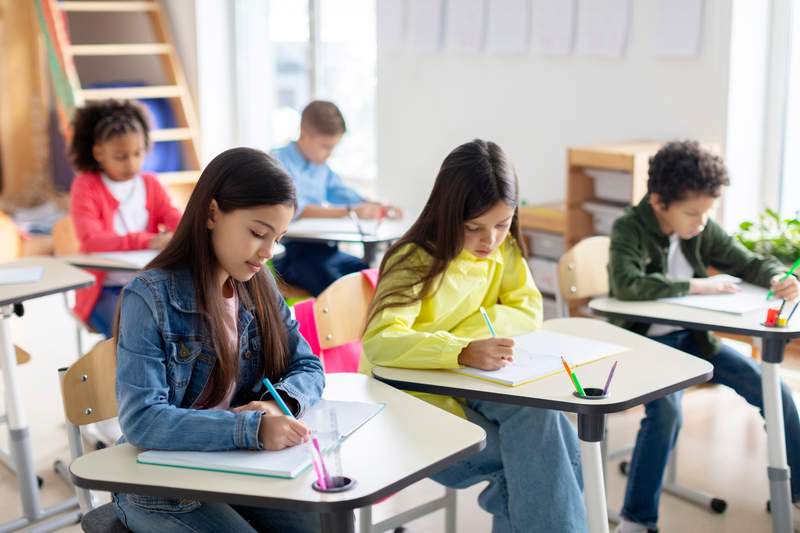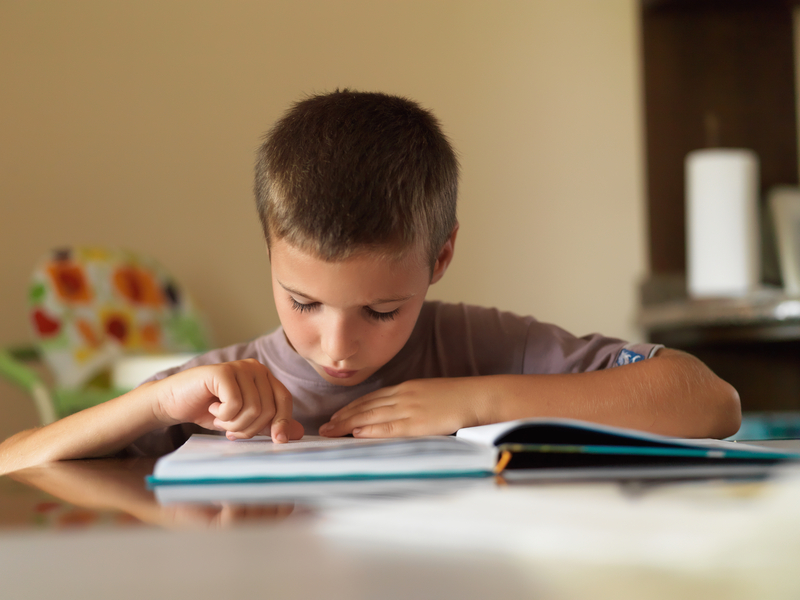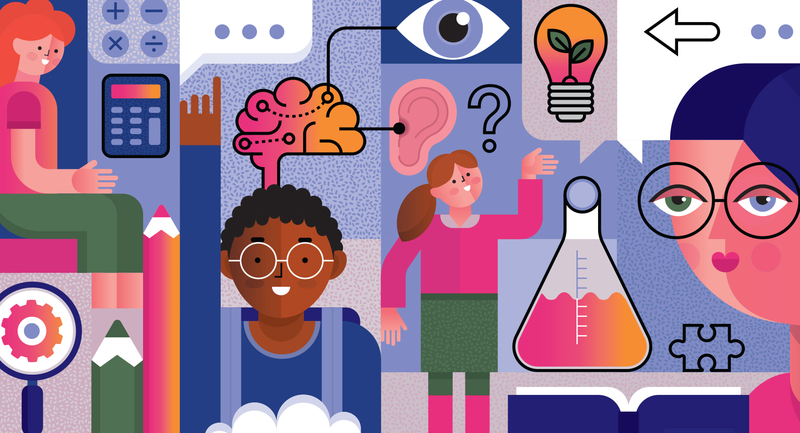English language arts teacher Pernille Ripp, who grew up in Denmark, doesn't remember many rich classroom-reading experiences. "We spent a lot of time with basal readers," she recalls. What she does remember are the bonds created when her mother read to her at home. "Those experiences made me a reader," she says. When she became a teacher, she knew that "read aloud would be how we built community."
Literacy expert Regie Routman agrees. In Literacy Essentials: Engagement, Excellence, and Equity for All Learners, she calls reading aloud an "indispensable first step in reaching and teaching [students]."
"It slows us down, relaxes us, reminds us of the joy and inspiration of a well-crafted story. Being read to puts us in the frame of mind for learning and increases literacy achievement," she writes.
Yet, as students age, they are less likely to be read to at school and at home. Ripp, who teaches 7th grade in Oregon, Wisconsin, explains, "One of the biggest misconceptions is that once kids pass 10 years old, they don't need to be read to—that there's no value in it. That's definitely not true." This misconception is embedded in a narrow understanding of the types of texts that can be read aloud and how reading aloud changes students.
The Swiss Army Knife of Literacy
Unlike shared reading—where students have text copies in hand and the reading is frequently interrupted for instruction or skill practice—a classroom read aloud involves one person (often a teacher) reading and pausing minimally to clarify a tricky term, make a connection, or ask questions related to a big idea. Most people have experienced a read aloud through a picture book or a novel, but any interesting text can be read aloud for a variety of objectives.
Teachers can use read alouds to create a class bond; promote a love of reading; preview information, themes, or text structures; model effective reading; show how texts connect with one another (intertextuality); or provide an exemplar for a genre of writing. The read aloud is like the Swiss Army knife of literacy; it has multiple uses at every age and in every content area.
Read alouds also create a bridge to more complex texts. A 1984 study by Thomas Sticht showed that a child's reading level doesn't catch up to their listening level until around 8th grade. That makes the read aloud a perfect opportunity to expose students to texts they can't yet decode for themselves. "While I'm reading aloud to my students, I'm doing the heavy lifting with vocabulary and decoding so that they can experience the joy of the text," explains Valentina Gonzalez, a professional development specialist for elementary English language learners (ELLs) in the Katy Independent School District in Texas. Hearing stories provides an oral language foundation and can improve acquisition of academic vocabulary, especially for ELLs.
Read alouds provide a scaffold to the reading and writing that students do on their own, adds Barbara Moss, a literacy expert and education professor at San Diego State University. And data show that children of any age who regularly have books read to them score higher on state and national literacy tests.
Don't Wreck the Read Aloud
Moss believes the strategic use of read alouds can help students achieve many of the goals of the standards, but she cautions: "Don't wreck the read aloud with too many instructional interruptions." Keep it simple and fun.
For example, don't have kids doing a lot of tasks during the reading. "I used to Post-it my students to death," recalls Ripp. "Write down or draw every thought that you have!" Then she realized she was losing students who were distracted by all the tasks. Now, she might have a couple of cues for students, but ultimately, her goal is to get to "where we're just so deeply immersed in the story that they beg for another page."
"Don't worry about kids understanding every word," says Routman. "Just find a great story. They will get it." Preread the text on your own, and then pull out all the stops as you read it in class. And remember, you're never too old to get something out of a great picture book, she adds.
Consider, too, how images, illustrative gestures, or a slower rate of speech can help ELLs overcome language barriers, says Gonzalez. Are there terms to preteach so that ELLs can access the text? How will all students, but ELLs especially, process the text during or after the reading?
Don't be afraid to scrap a book if kids just aren't into it. Moss recalls an excellent student teacher who made the fatal flaw of reading aloud a long, complicated passage on the water cycle. "It went on for a half an hour and the kids were dying."
That doesn't mean informational texts are read-aloud kryptonite. Moss remembers a 1st grader who told her, "I don't want to read stories about bears with clothes on. I want to read about real stuff." From coverage of current events to discoveries in STEM, short, engaging articles abound and make great sources for read alouds. An inspiring New York Times article on Chef José Andrés feeding thousands in Puerto Rico could initiate a discussion of what makes a hero, suggests Routman.
Priority, Purpose, Process
Amanda Zieba, who teaches middle school English language arts and reading in La Crosse, Wisconsin, has been reading aloud to her students for a decade. Although she has refined her methods and expanded her bookshelf to include everything from picture books to obituaries, her guiding principle has remained constant: "I want my students to like reading."
She's found that starting class with a read aloud, followed by 10 minutes to write in journals, provides a predictable structure that helps kids settle into the day's lesson. Having a set process also prevents the read aloud from getting scrapped because of time constraints.
To make the case for read alouds as a worthy use of class time, Routman encourages teachers to be knowledgeable about the research-based rationale and then "invite your principal into your classroom during a read aloud so [that] they can listen to the level of conversation that takes place and see how engaged kids are."
Your Best Book Club
Successful read alouds have a clear purpose that you plan toward, says Tanya Friedman, an educator and coach with the ATAPE Group in New York City. Last year, she worked with a team of 2nd grade teachers at Young Leaders Elementary (P.S. 369) in the South Bronx to help them make read alouds more rigorous and culturally relevant.
Teachers at P.S. 369 wanted to give their students, a large portion of whom are ELLs, more tools to discuss the high-level ideas within the texts they were reading. The questions and cues teachers had been using during the read aloud, however, focused students on literal comprehension, which, in turn, reinforced low expectations for student thinking. It also drained the life out of the read aloud. "What's the conversation in a good book club? Rarely is it recounting what happened in the book," says Friedman.
By videotaping student discussions, teachers at P.S. 369 could see that students didn't have the skills to have dynamic conversations. Working backward from this goal, they developed a read-aloud planning guide that incorporated Bloom's Taxonomy and Webb's Depth of Knowledge to fine-tune the types of questions teachers ask.
"If we stop and say, 'Who remembers where the mother is going?', that's what we're prepping them to talk about," explains Friedman. "But if we stop and say, 'Why do we think the mother had that look on her face? What other experiences might she have had that made her not trust this person?', then we are prepping students to have a different type of conversation."
That doesn't mean literal comprehension gets tossed. If teachers notice student comprehension is shaky, they can recap events or make that a focus of small-group work. "We have to teach literal comprehension, but to me, that's not what [a] read aloud is for," says Friedman. Kids need to practice comprehension in small groups, at their level. But higher-order thinking? "All kids can do that, so that's what should be happening during a read aloud."
Relevant and Rigorous
Making lively, academic conversations the goal of a read aloud also changed how teachers at P.S. 369 select books to read. Friedman says the new approach considers what's on students' minds, their experiences, and what they're talking about. (Get tips on text selection in "How to Pick a Good Read-Aloud Text".)
For example, they read Mama's Nightingale by Edwidge Danticat, a book about deportation that would've previously been considered too heavy for 2nd graders. With the new lens of rigor and relevance, however, Friedman says, "we could see that it would lead to really amazing conversations." Teachers were surprised by how much their students already knew about detention centers and fear of immigration police.
"Read aloud is a way to honor students' culture and interests, as well as build background and vocabulary," notes Routman. A culturally relevant read aloud creates a self-propelling cycle of engagement where students not only want to learn more, but also want to do something with their new knowledge. "They're like, 'Let's write letters. What else is unfair? What can we do about it?'," says Friedman. "That's what we want school to be—connected to kids' real lives."
We Speak Books
A few years into her teaching career, Ripp decided to take her experiments with read aloud to a world stage. She created the Global Read Aloud, a monthlong event that brings classrooms around the world together over books. What started with 300 students and one book (The Little Prince), has grown in its 8th year to include more than 2.2 million students in 80 different countries, four books, and an author study. Like her classroom read alouds, Global Read Aloud "brings us together and makes us speak books," says Ripp. It's a lot like learning a new language together, she continues.
That's because read alouds sensitize students to the language and structures of texts—not just stories, but informational texts, too, says Moss. It creates a shared signpost in students' minds, pointing out the connection between what they heard and the learning that follows. For example, in 7th grade, Zieba reads aloud The Boy in the Striped Pajamas as a bridge to a historical unit on the Holocaust. "It's not complex in terms of the level of text, but it is helping my students understand a complex topic."
"Stories lean on other stories," Moss quotes author Jane Yolen. As students begin to notice elements of plot, style, and language, they start to draw comparisons between what they hear in the read aloud to what they read on their own. "These connections, or intertextualities, fuel not only comprehension but also a vibrant community around reading."
A New Relationship to Reading
Since the shifts at P.S. 369, students are eager for read alouds and engaged in discussion. When asked about books, students are more likely to talk about big meanings, rather than small details. In general, their disposition to reading has changed. "They want to read more; they want to find more books like that one," notes Friedman.
"Many of my kids come in as proudly resistant readers," says Ripp. "When we say, 'OK, listen to this,' all of a sudden, they start to wonder, 'Maybe that book is not a fluke? Maybe there are others like it?'"
Kids have a lot of choices for how they spend their time, notes Moss. "We want reading to be one of the things they choose." Reading aloud can motivate that choice, and that alone makes it a valuable use of class time. It can also add life to lessons: "Read aloud is a reset, a way to bring the joy back to teaching," says Routman.
Ripp says she hasn't found anything that binds her classes together like read alouds. "Read alouds become part of who we are; [they] become part of our memories."








